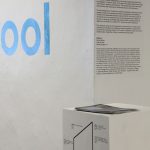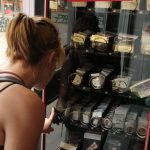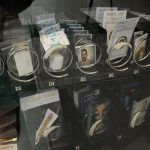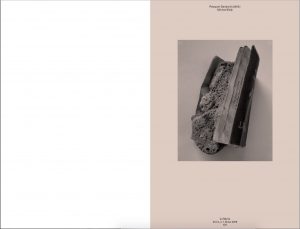A feature that appeared in Art World Magazine (艺术世界) issue 250, March 2011.
published May 20, 2018
22.11.2016
The cancelled course
Night night dark night university study job time purpose. Night feeling irrelevant day ice crack vague wonder work rewards wonder. Night power dreaming yawning writing vapid budget domestic patient time up. Night cold dark long apartment street lights passing relativity complaints heaven depression insufferable travel sites refugees becoming undesirable. Night reflection time quiet hum plastic sheeting workdays coughing children internet breakfast cycle clothing deadend haircut. Night artist joke no answer sorry grow up night bed stomach hungry causal relation friends comparison status uncertain practice night push it elsewhere airplane pollution creaky floor sand dune moon indifference time zone static winter night. Night try and fail waiting light waiting news late email breakfast daycare three hours exchange baby lunch night face hair bumps evacuation silence crying patience future present night tomorrow routine video. Night friends there problems death gratitude impossibility shrugs live and let live don’t push it mental sanity night sleep clenched jaw laundry pile do the easy things success message no reflection tweets no grammar friend no time night comparison. Night experience night life memory useless practice bicycle know ride trust no knowledge work it out no masterpiece no resistance aspirational night busy miserable alive dark humour no comprehension buddhists night history. Night novel night entertainment night practice incomplete close reading advice professional finish deliberate delay skill set teachable language human capital varied frozen paid hobby whale school night innovation transferable confidence name night.
published May 3, 2018
In the summer of 2017, the Readymade Institution course, led by Michael McCormack and Michael Eddy, organized an exchange project between Think School, an independent art course in Sapporo, Japan, and the Readymade Institution, NSCAD University. Each class installed the work of the other. Exhibition views from the Readymade Institution show in Public Art Research Center in Sapporo, Japan ↓
I showed a Japanese-translated version of Protest Debate.
Exhibition views from Think School show in Anna Leonowens Gallery 3 ↓
Think School exhibition announcement:
The Readymade Institution class presents Think School
Anna Leonowens Gallery 3
NSCAD University Fountain campus
August 14, 2017—August 19, 2017

Think School is a small, independently run art course organized by artists in the city of Sapporo, in Northern Japan. Their motto (in the speech bubble of their logo) is “Art school to make the city interesting.” Their classes meet once a week and feature lectures and workshops on various themes around art and culture.
For this exchange show, Think School students and teachers were given an open mandate, whose only constraints were those of transportation and translation. Students in the Readymade Institution Class at NSCAD U act as the curators of the received work, and collectively work out the arrangement and mediation of the show.
In exchange, the Readymade Institution Class is sending its work to Sapporo for an exhibition in October 2017, around the motif of instructions.
This process of caring for and interpretation of work sent from a remote context illuminates central aspects of portable and alternative galleries. Throughout our course we have discussed themes of DIY culture, institutional critique, community, variable scales, marginality, intimacy, movement and public space.
Gallery 4
Fallow Gallery
Granville Mall
NSCAD University Fountain campus
Opening August 14


Among the group exercises undertaken in this course is the occupation of the Fallow Gallery, located in the Granville Mall (inside entrance between NSCAD Fashion dept. and the Art Bar). This vending machine-cum-art gallery initiated by then-students of NSCAD U Jacob Perry and Jolee Smith offered a venue to sell art pieces after the closure of the Seeds Gallery in 2013. It had been lying dormant for several months until Jacob and Jolee offered the use of the gallery to the Readymade Institution class. This exhibition , launching the same day as the Gallery 3 show in the Anna Leonowens Gallery, is called “Gallery 4”. All the works in the machine are offered for the minimum denomination the machine will accept, a nickel. (It should also be mentioned that the Fallow Gallery is open to new management by interested NSCAD students.)
published November 28, 2017
As part of the launch of le merle #5, entitled “on ne répond pas à la question. contre toute attente on procède.” and folded into the event series trilogie électorale, I screened the video Infinite Cruelty, for nothing at Galérie UQO (20/10/2017) and at Musée d’art contemporain des Laurentides (MACL; 04/11/2017). I also realized a version of money drawing (Lump) at the MACL, seen above.
See the French subtitled version of Infinite Cruelty, for nothing here.
password: credit check

And see the pdf of le merle #5 here: LeMerle05
published November 26, 2017
This text appeared in the artist Jon Knowles’ monograph The Last Decayed, published 2015 by Fonderie Darling.
See the PDF: Past-performance_michael-eddy
published August 21, 2017
Seen above is an installation along with work by Sara Hartland-Rowe and Michael Fernandes (who invited me).
Works:
Timeshares
2016
6 standard tree swallow birdhouses, pinhole photography, installation
Experience a place like you live there (cleaning an Airbnb)
2015-2016
video (12’51”)
Statement
The next morning the artist Michael Fernandes reported to me on the noises assaulting his cabin. He swore there were two gangs of swallows engaged in a nightlong fight over territory, which overflowed into the airspace over his bed, as well as what sounded like a woodpecker and even a squirrel making claims on the eaves and the metal roof. Other campers filed similar reports and staff brought a ladder over to try to free some of the birds (garden variety starlings) to the wide open, harsh world.We all come from somewhere. We are squatting in someone else’s cabin.
We all come with something. Despite this residency project’s premise of call and response, I came with a desire to try my hand at pinhole photography. In no way intended as a solution to the real estate crunch, I decided to build a series of birdhouses of standard design. What is a birdhouse but a camera? The prolific local artist David Taylor’s work pointed out to me the possibilities of this vernacular object: his weathered grandfathers hanging watchfully over Canning wait readily to swallow and regurgitate feathered creatures as if harbouring a cult of informants. My birdhouses would be converted and used first as pinhole cameras, then, after my time at Ross Creek, turned over to the birds.
The video presented alongside incorporates footage from a job I held occasionally last year, cleaning a friend’s Airbnb apartment in Montreal. The audio is derived from the aforementioned cabins at Ross Creek Arts Centre. While sitting with Michael Fernandes in the Centreville Kwik Way, where we were assessing french fry quality and appreciating the hamburger paintings, we caught part of a program being screened on their plasma screens. The National Geographic channel was playing, an excited zoologist was explaining her latest discovery. In the Amazonian jungle, a new species of bear had been identified. The most interesting trait (she called it “revolutionary”) was not the secretive bear’s appearance, which was sort of small and thin and blackish, nothing to write home about, but the bear’s habits of collecting and distributing its quarry and other materials. This is where, in my opinion, the scientist seemed to get ahead of herself. She called this the bear’s “economic activity.” What shocked the team of experts was the bear’s practice of remitting portions of what it had confiscated back to producers, including bees and termites, but even more so its exchanging portions with other species—always for a profit. Of course, there was no way to prove the bears were consciously calculating in such a system, but this zoologist and her team found reasonable ground to assert this as the first evidence of a truly capitalist tendency in nature. And the cherry on top, which filled the narrator’s voice with audible glee, was that this was great for the jungle’s ecology. The ecosystem was healthiest and most abundant wherever this bear was active. “In order to advance into the perma-green economy,” the zoologist postulated, her eyes gleaming intensely in a close-up, “we must learn from the capitalist bear.” Michael and I thought the fry portion was still a little on the skimpy side for a “large.” Yet that day we left a single fry on the plate and drove back to Ross Creek in the generous rain.
Michael Eddy
published July 25, 2016